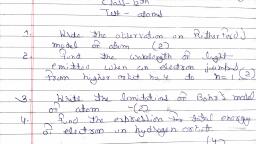Question 1 :
When the speed of electrons increases, then the value of its specific charge
Question 2 :
An electron at rest is accelerated through a potential difference of 200 V. If the electron acquires a velocity $8.4 \times 10^6 m/s$, the value of e/m of electron is
Question 3 :
Particles used in the Rutherford's scattering experiment to deduce the structure of atoms.
Question 5 :
When a hydrogen atom is raised from ground energy level to excited energy level, then
Question 6 :
The velocity of electrons accelerated by potential difference of $1\times 10^{4}V$ (The charge of the elctron is $1.6\times 10^{-19}C$ and mass is $9.11\times10^{-31}$kg) is<br/>
Question 7 :
An electron with kinetic energy 5 eV is incident on ahydrogen atom in its ground state. The collision
Question 8 :
In hydrogen atom, if the difference in the energy of the electron in $n=2$ and $n=3$ orbits is $E$, the ionization energy of hydrogen atom is
Question 9 :
In a Rutherford experiment, the number of particles scattered at $90^{\circ}$ angle are 28 per minute then number of scattered paticles at an angle $60^{\circ}$ and $120^{\circ}$ will be<br>
Question 10 :
An electron is accelerated by a Potential Difference of 1000V. Its velocity will be
Question 11 :
If a retarding potential of 1 V is applied between electrodes at what limiting wavelength $\lambda$ of light incident on the cathode will the photoelectric effect begin?
Question 12 :
The Rutherford $\alpha$-particle experiment shows the most of the $\alpha$-particles pass through almost unscattered while some are scattered through large angles. What information does it give about the structure of the atom?<br>
Question 13 :
The total energy of the electron in the hydrogen atom in the ground state is -13.6 eV. Which of the following is its kinetic energy in the first excited state?
Question 14 :
Rutherford's experiments suggested that the size of the nucleus is about
Question 15 :
In an electron gun,the potential difference between the filament and plate is 3000V. What will be the velocity of electron-emitting from the gun?


























